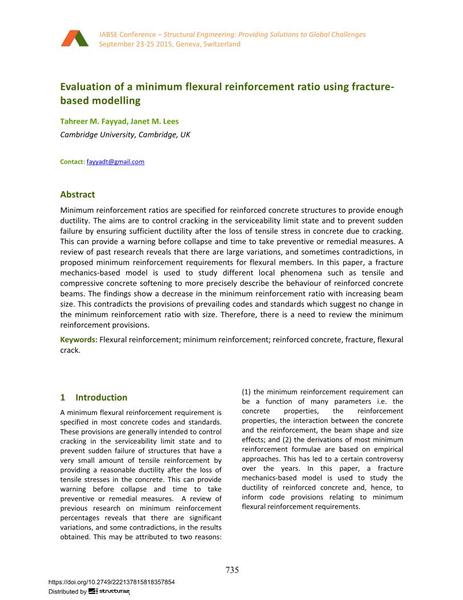Evaluation of a minimum flexural reinforcement ratio using fracture-based modelling

|
|
|||||||||||
Détails bibliographiques
| Auteur(s): |
Tahreer M. Fayyad
(Cambridge University, Cambridge, UK)
Janet M. Lees (Cambridge University, Cambridge, UK) |
||||
|---|---|---|---|---|---|
| Médium: | papier de conférence | ||||
| Langue(s): | anglais | ||||
| Conférence: | IABSE Conference: Structural Engineering: Providing Solutions to Global Challenges, Geneva, Switzerland, September 2015 | ||||
| Publié dans: | IABSE Conference Geneva 2015 | ||||
|
|||||
| Page(s): | 735-742 | ||||
| Nombre total de pages (du PDF): | 8 | ||||
| Année: | 2015 | ||||
| DOI: | 10.2749/222137815818357854 | ||||
| Abstrait: |
Minimum reinforcement ratios are specified for reinforced concrete structures to provide enough ductility. The aims are to control cracking in the serviceability limit state and to prevent sudden failure by ensuring sufficient ductility after the loss of tensile stress in concrete due to cracking. This can provide a warning before collapse and time to take preventive or remedial measures. A review of past research reveals that there are large variations, and sometimes contradictions, in proposed minimum reinforcement requirements for flexural members. In this paper, a fracture mechanics-based model is used to study different local phenomena such as tensile and compressive concrete softening to more precisely describe the behaviour of reinforced concrete beams. The findings show a decrease in the minimum reinforcement ratio with increasing beam size. This contradicts the provisions of prevailing codes and standards which suggest no change in the minimum reinforcement ratio with size. Therefore, there is a need to review the minimum reinforcement provisions. |
||||
